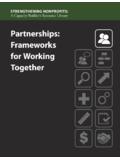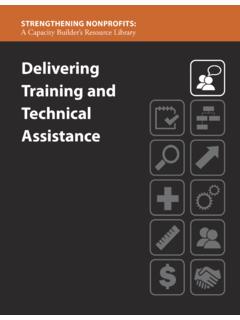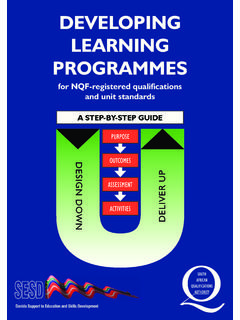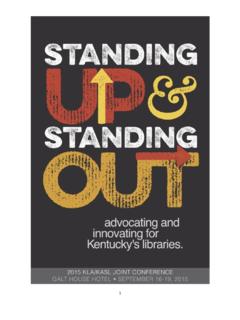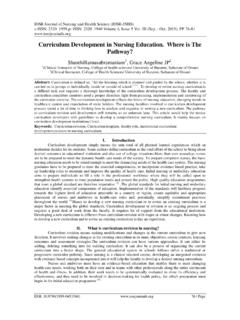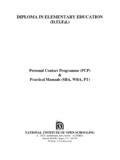Transcription of Identifying and Promoting Effective Practices
1 Identifying and Promoting Effective PracticesSTRENGTHENING NONPROFITS: A Capacity Builder s Resource LibraryTABLE OF CONTENTSINTRODUCTION ..3 OVERVIEW ..4 What Are Effective Practices ? ..4 Why Identify Effective Practices ? ..6 Potential Practice Areas ..6 Identifying Effective Practices ..7 Identifying PRACTICE NEEDS ..8 Identifying Programmatic Needs ..8 Identifying Organizational Needs ..8 Identifying Effective Practices ..9 Identifying Existing Practices ..9 Validating Existing Practices ..10 Identifying and Validating New Practices ..10 Formal Evaluation: The Next Level ..14 Promoting Effective Practices ..15 Internal Promotion ..15 Peer-to-Peer Learning ..16 SUMMARY.
2 16 APPENDICES ..18 APPENDIX A: Resources and References ..18 APPENDIX B: Glossary ..20 APPENDIX C: Checklist for Identifying Effective Practices ..213 INTRODUCTIONThe Compassion Capital Fund (CCF), administered by the Department of Health and Human Services, provided capacity building grants to expand and strengthen the role of nonprofit organizations in their ability to provide social services to low-income individuals. Between 2002 and 2009, CCF awarded 1,277 grants, and the CCF National Resource Center provided training and technical assistance to all CCF grantees. Strengthening Nonprofits: A Capacity Builder s Resource library is born out of the expansive set of resources created by the National Resource Center during that time period, to be shared and to continue the legacy of CCF s capacity building work.
3 Strengthening Nonprofits: A Capacity Builder s Resource library contains guidebooks and e-learnings on the following topics:1. Conducting a Community Assessment2. Delivering Training and Technical Assistance3. Designing and Managing a Subaward Program4. Going Virtual5. Identifying and Promoting Effective Practices6. Leading a Nonprofit Organization: Tips and Tools for Executive Directors and Team Leaders7. Managing Crisis: Risk Management and Crisis Response Planning8. Managing Public Grants9. Measuring Outcomes10. Partnerships: Frameworks for Working Together11. Sustainability12. Working with ConsultantsWho is the audience for Strengthening Nonprofits: A Capacity Builder s Resource library ?
4 Anyone who is interested in expanding the capacity of nonprofit services in their community from front line service providers to executives in large intermediary organizations will benefit from the information contained in this resource library . The National Resource Center originally developed many of these resources for intermediary organizations, organizations that were granted funds by CCF to build the capacity of the faith-based and community-based organizations (FBCOs) they served. As such, the majority of the resources in Strengthening Nonprofits: A Capacity Builder s Resource library support intermediary organizations in their capacity building efforts.
5 However, funders of capacity building programs (Federal program offices and foundations) and the nonprofit community (including FBCOs) at large will also find these resources helpful. In addition, individuals working to build capacity within a program or an organization will be able to use these resources to support their efforts to implement change and make Identifying and Promoting Effective Practices guidebook will be helpful to any intermediary or coalition interested in sharing knowledge among a group of organizations about Effective Practices and what works for those developed the Identifying and Promoting Effective Practices guidebook? The guidebook was originally developed by the National Resource Center with assistance from Mark Publow.
6 It was updated in 2010 for the Department of Health and Human Services by the National Resource Center. 4 OVERVIEWBy reading this particular guidebook, nonprofit organizations will equip themselves with the knowledge and information needed to identify, validate, and promote Effective Practices that will help improve their organization and the quality of services they provide within their communities. The process of systematically improving performance by Identifying , understanding, and adapting successful Practices is often referred to as benchmarking. Benchmarking was first utilized extensively in the business sector in such areas as manufacturing, information technology, and healthcare management.
7 Over the past decade, efforts have been increasingly made to encourage the adoption of Effective practice methodologies in the nonprofit sector. As awareness of Effective Practices has grown, so has the need for the development of a standardized process for benchmarking them. To date, this skill set has resided predominantly in research-based institutions such as universities and policy research institutes. More recently, however, nonprofits and nonprofit intermediary organizations have begun to develop methodologies around the identification and promotion of Effective Practices . Since these practitioner organizations generally focus on providing direct program services or capacity building activities, they often do not have access to the research skills or other resources that corporate or academic institutions use to identify Effective Practices .
8 However, nonprofits have a definitive need for accessible, useful processes and tools that can assist them in the benchmarking reading this guidebook, nonprofit organizations will better understand the key elements required to identify and promote Effective Practices : Understanding the three types of Effective Practices best, promising, and innovative Identifying existing best, promising, and innovative Practices Identifying and validating Effective Practices Promoting Effective Practices This guidebook will also help organizations answer several key questions: Why are Effective Practices important? What are the differences between best Practices , promising Practices , and innovative Practices ?
9 How do you identify existing Practices ? How do you identify and validate new Practices ? What are some useful tools for teaching others to identify and incorporate these Practices ?For the remainder of this guidebook, the terms practice, Effective practice, and potential practice refer to any practice that has yet to be classified as best, promising, or Are Effective Practices ?When Identifying Effective Practices it is important to begin with a clear understanding of what qualifies as a practice. A practice can refer to an activity, strategy, methodology, system, process, technique, tactic, or approach. For example, a youth-serving mentoring organization may discover that utilizing online social networking sites to recruit mentors or electing youth ambassadors to sit on the organization s board of directors are both Effective Practices .
10 5 Definitions and standards around what constitutes an Effective practice vary throughout the nonprofit sector. Different nonprofit organizations use different criteria to identify and classify Effective Practices . This is also true across sectors of the corporate world different definitions are used within the business arena and the healthcare industry, for addition to a variety of criteria, there is also limited agreement on the terms used to refer to an Effective practice. But regardless of the terminology, it is important that a practice has clearly defined parameters that can be assessed for effectiveness and compared against similar the purposes of this guidebook, it is useful to reference the following definitions: Effective practice a general term used to refer to best, promising, and innovative Practices as a whole.
